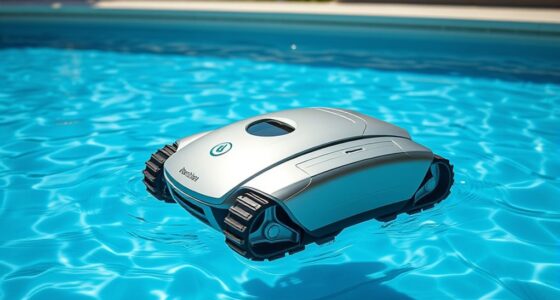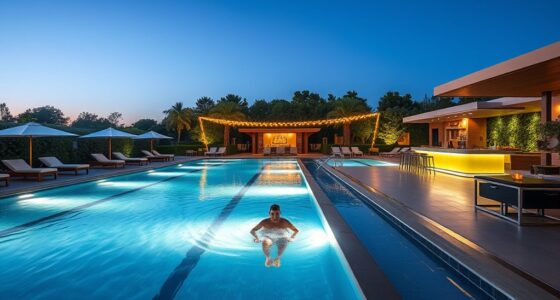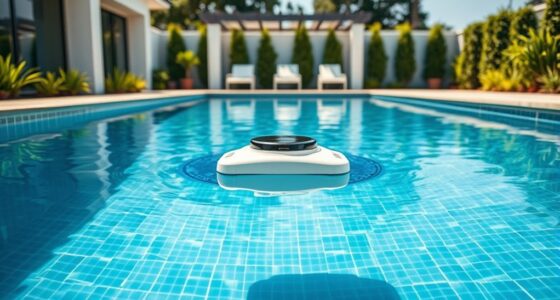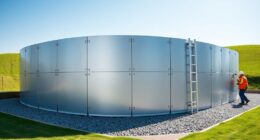Switching to sustainable pool systems with solar heating and energy-efficient pumps helps you lower your environmental impact and reduce energy bills. Solar collectors capture sunlight to heat your pool naturally, while efficient pumps use less power to circulate water, saving you money. Ensuring proper installation and regular maintenance keeps everything running smoothly and prolongs equipment life. To discover how combining these technologies can maximize your savings and eco-friendly benefits, keep exploring your options.
Key Takeaways
- Solar heating systems harness sunlight to warm pool water, reducing reliance on conventional energy sources and lowering carbon emissions.
- Energy-efficient pumps use less electricity and offer variable speeds, enhancing overall pool system efficiency and reducing utility costs.
- Proper installation, such as optimal panel placement and regular maintenance, maximizes solar capture and equipment lifespan.
- Combining solar heating with energy-efficient pumps minimizes environmental impact and promotes sustainable pool operation.
- Incentives and rebates may be available for installing eco-friendly pool systems, making sustainable upgrades more affordable.
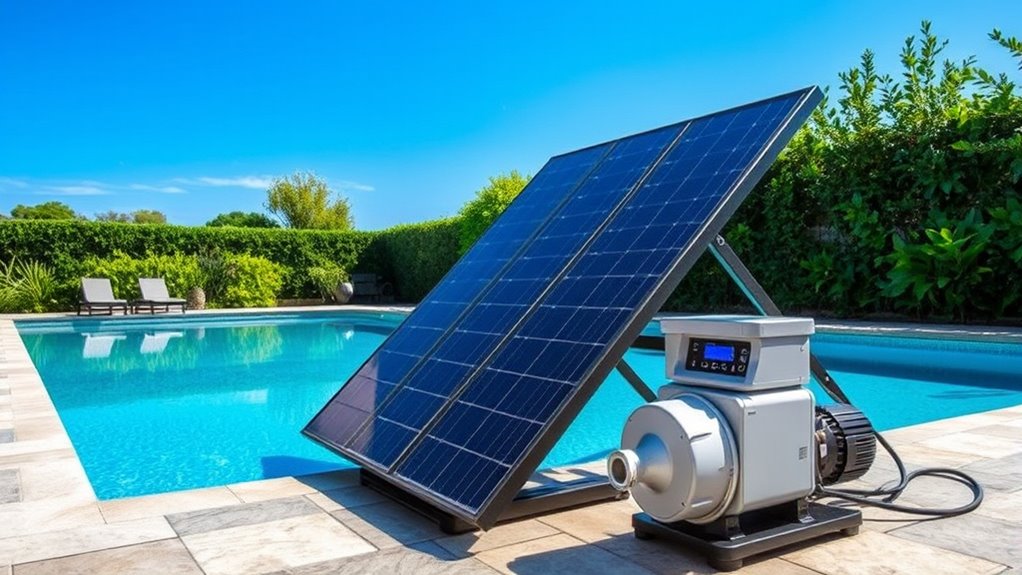
Have you ever wondered how to enjoy an invigorating pool while minimizing your environmental impact? The good news is, you can do both with sustainable pool systems that emphasize solar heating and energy-efficient pumps. By integrating solar panels into your pool setup, you harness the sun’s free, renewable energy to warm your water, reducing reliance on conventional energy sources. Solar pool heating systems work by capturing sunlight through collectors, which then transfer heat to your pool water. This process not only cuts down on electricity or gas bills but also markedly lowers your carbon footprint. It’s a smart way to conserve energy while maintaining a comfortable swimming temperature year-round, especially in sunny climates.
Enjoy your pool responsibly with solar heating and energy-efficient pumps to save energy and reduce your carbon footprint.
Energy conservation plays a vital role in sustainable pool management. Upgrading to energy-efficient pumps can dramatically decrease electricity consumption. These pumps are designed to operate with less wattage while still delivering the necessary water circulation. Unlike traditional models that often run at full capacity regardless of need, energy-efficient pumps can be programmed for variable speeds, adjusting their output based on your pool’s requirements. This means you’re not wasting power when the pool doesn’t need as much circulation, which translates into lower energy bills and less strain on power grids. When combined with solar heating, these pumps optimize your pool’s efficiency even further, making the entire system more eco-friendly and cost-effective.
To maximize the benefits of these sustainable systems, it’s essential to pay attention to proper installation and maintenance. Properly positioned solar panels will capture the maximum amount of sunlight, especially if installed on a south-facing roof or a dedicated sunny area. Regularly cleaning and inspecting the panels ensures they perform at peak efficiency. Similarly, maintaining your energy-efficient pump involves checking for leaks, debris, and ensuring it’s operating within its ideal parameters. These small steps extend the lifespan of your equipment and guarantee that your pool remains environmentally friendly over the long term.
Implementing noise reduction technology in your pool system setup can further enhance the overall experience by minimizing disturbances caused by equipment operation. Adopting sustainable pool systems isn’t just good for the planet—it’s good for your wallet too. Over time, the reduced energy consumption can lead to substantial savings on utility bills. Plus, these systems often qualify for rebates or incentives, making the initial investment more affordable. By choosing sustainable pool systems, you’re making a conscious decision to enjoy your pool responsibly, without sacrificing comfort or fun. It’s a proactive way to contribute to a healthier environment while still indulging in the joys of swimming. With a little planning and maintenance, your pool can become a model of efficiency and sustainability for everyone to admire.
Frequently Asked Questions
How Long Does Solar Pool Heating Typically Last?
Solar pool heating systems typically last 10 to 20 years, depending on solar panel durability and maintenance. You should check the warranty coverage, as most providers offer warranties of 10 to 15 years, which can give you peace of mind. Proper care, like regular cleaning and inspections, can extend the lifespan. Ultimately, investing in high-quality panels with good warranty coverage guarantees you get the most out of your system.
Are Energy-Efficient Pumps Compatible With Existing Pool Systems?
Yes, energy-efficient pumps are compatible with most existing pool systems. Pump compatibility depends on your system’s specifications, but many models are designed for easy system integration. You should check your current pump’s size and connection types to guarantee a seamless fit. Upgrading to an energy-efficient pump can improve performance and reduce energy consumption, making your pool system more sustainable and cost-effective.
What Maintenance Is Required for Solar Pool Heating Systems?
You should regularly inspect your solar pool heating system for debris and leaks to guarantee ideal performance. Keep your pool cover efficient by cleaning it and maintaining proper chemical balance to prevent algae and buildup. Additionally, check the pump connections and clean filters as needed. Proper maintenance not only prolongs system life but also maximizes energy savings, keeping your pool warm and inviting with minimal effort.
How Much Can I Save on Energy Costs Annually?
You can expect to save around 50-70% on energy costs annually with solar pool systems, leading to significant cost savings. The annual reduction in energy bills depends on your pool size, usage, and local sunlight, but most users see a noticeable decrease in expenses. Over time, these savings can offset the initial investment and contribute to a more sustainable, eco-friendly pool setup.
Can These Systems Operate Effectively in Cloudy Weather?
While cloudy weather might seem like a setback, these systems can still operate effectively because they’re designed to maximize system efficiency even in less sunny conditions. You might notice slower heating, but the solar collectors still absorb diffuse sunlight, providing warmth. So, don’t worry—your solar heating system continues working, just with a little less intensity. It’s a smart way to keep your pool warm without relying solely on direct sunlight.
Conclusion
By choosing solar heating and energy-efficient pumps, you’re not just saving energy — you’re transforming your pool into an unstoppable force of sustainability! Imagine your pool running forever on the power of the sun, making energy bills vanish like magic. With these systems, you become a superhero of eco-friendliness, saving the planet one splash at a time. Embrace these innovations now, and watch your pool revolutionize your backyard into a legendary, green oasis!


